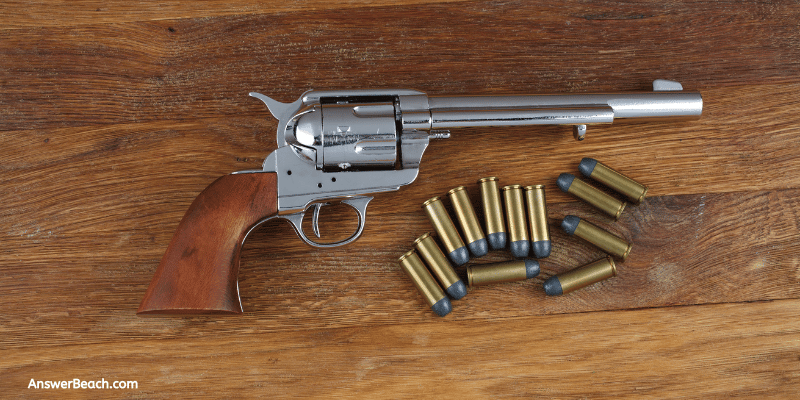When it comes to firearms, there are two basic styles of action.
What are the two basic styles of firearm actions?
The two basic styles of firearm actions are single action and double action. Single action firearms must be cocked before each shot, whereas double action firearms can be fired without cocking the weapon first. You can also refer to double-action firearms as repeated actions or automatic actions.
In this article, you’ll learn everything you need to know about the two basic styles of firearm actions.
What Is a Firearm Action?

A firearm is a weapon that uses an explosive charge to fire a projectile at high velocity.
Firearms come in many different shapes and sizes, but they all have one thing in common: they have action. The action is the mechanism that loads, cocks, and fires the gun.
It is the part of the gun that keeps the bullet in place and provides the energy needed to fire it.
There are many different types of actions, but they can all be divided into two basic categories: single-action and double-action.
You can also talk about semiautomatic and fully automatic. Semiautomatic firearms tend to have a single action: they load a new round into the chamber with each pull of the trigger.
Fully automatic firearms have multiple actions: they load a new round into the chamber and fire it with each pull of the trigger.
The type of action determines how fast a gun can fire and how often it needs to be reloaded.
Here is a very good and comprehensive video about firearm actions types for beginners:
What Are Single Action Firearms?
A single-action firearm is one where the hammer must be manually cocked before each shot.
In a double-action firearm, the hammer is automatically cocked when the trigger is pulled. Each style has its own advantages and disadvantages.
Pros
Single-action firearms are typically small and lightweight, making them easy to carry and conceal. They also tend to have a shorter overall length, which can be an advantage in close-quarters combat.
Single-action firearms are also typically less expensive.
Cons
On the downside, single-action weapons can be difficult to fire accurately in rapid succession due to the need to manually cock the hammer between each shot.
Examples of Single Action Firearms
Single action guns are typically older models, and as such, there are a number of iconic examples of this type of firearm.
One well-known single-action gun is the Colt revolver used by the likes of Wyatt Earp and Annie Oakley. These guns were popular due to their sleek design and quick firing capabilities.
Another example of a single-action firearm is the Winchester rifle, which was used by frontiersmen in the American West.
This rifle was prized for its long-range accuracy and reliability in harsh conditions.
Today, single-action firearms are still popular among collectors and marksmen alike. Though they may not be as common as their double-action counterparts, these guns still have a place in the modern world.
What Are Double-Action Firearms?
Pros
Double-action firearms offer a number of advantages in terms of convenience and safety.
For one, they don’t require the user to cock the hammer before each shot, making them much easier to fire in rapid succession.
They also tend to have a longer overall length, which can give the user a better sight picture and more control over the weapon.
Cons
Double-action firearms are typically larger and heavier than their single-action counterparts.
This makes double-action weapons more difficult to conceal due to their size and weight.
Examples of Double-Action Firearms
Some examples of double-action firearms include:
- Smith & Wesson Model 10 Revolver
- Ruger LCR revolver
- Beretta 92FS pistol.
What’s the Most Basic Firearm Action?
The most basic firearm action is a single action.
In this type of action, the shooter must manually cock the hammer before each shot. This can be done by pulling the hammer back with the thumb or forefinger.
The single action is often used in revolvers, but it can also be found in some larger firearms, such as rifles.
While it is not as fast or convenient as other types of actions, it is very simple to use and well-suited for firearms that are meant to be fired slowly and deliberately.
For these reasons, the single action is often preferred by those who are new to shooting or who want a reliable and uncomplicated firearm.
From there, actions evolve to double-action and multiple-action.
What Is the Most Common Basic Firearm Action?
The majority of modern handguns are double action, as this allows for a faster rate of fire.
Why else are most guns double action?
There are actually a few reasons. First, double-action guns are generally more reliable because there are fewer moving parts that can break or become jammed.
Second, double-action guns are usually easier to fire accurately because the trigger pull is shorter and smoother.
For these reasons (and others), double-action is typically the preferred type of gun for most law enforcement and civilian use.
Single Action Vs Double Action: Which Is Better?
Some shooters prefer single-action weapons for their accuracy and precision. Others like the speed and smoothness of double-action.
Ultimately, the choice of action type is a matter of personal preference.
If I was going to pick one action type, I’d go with double-action.
Here is why the double-action is better:
- More popular
- More available
What Are Other Firearm Actions?
When it comes to firearms, there are a lot of different terms thrown around.
Here are some other firearm actions and what they mean:
- Break Action
- Bolt Action
- Pump Action
What Is Break Action in Firearms?
For example, what the heck is a break action.
Break action is defined as a type of firearm where the barrels are hinged on the forward part of the receiver and the breechblock is mounted in two ( generally locking ) parts that pivot on pins at the rear of the receiver.
The breechblock functions as both the cylinder and bolt.
In most cases, when the firearm is “broken open ” for loading, an extractor pulls spent cartridges from the breechblock’s chambers and allows fresh ones to be inserted.
The break action is one of the oldest and most simple designs for a firearm, and as such has been adapted for a wide variety of different purposes.
Rifles and shotguns can be found in break-action designs.
What Is a Bolt Action Firearm?
A bolt-action firearm is a type of gun that uses a rotating bolt to chamber rounds.
Though bolt-action guns are often associated with hunting, they can be used for a variety of purposes. In general, bolt-action guns are more accurate than other types of guns, making them ideal for long-range shooting.
They can also be outfitted with a variety of different scope options, further increasing their accuracy.
Additionally, bolt-action guns tend to be more durable than other types of firearms, meaning they can withstand more wear and tear.
However, one downside of bolt action guns is that they are generally slower to fire than other types of guns.
What Must You Check To Make Sure a Bolt-Action Firearm Is Unloaded?
If you’re new to firearms, you may not know how to properly check if a bolt-action rifle is unloaded.
Here’s a quick rundown of the steps you need to take.
- First, make sure the safety is on and the rifle is pointed in a safe direction.
- Then, open the bolt and remove the magazine (if there is one).
- Finally, open the action to visually inspect the chamber.
- Once you’ve confirmed that the chamber is empty, you can proceed with confidence knowing that the gun is safe to handle.
- Once you’ve done all of this, you can be confident that the rifle is unloaded and safe to handle.
Of course, it’s always important to follow basic gun safety rules whenever you’re handling firearms. If you’re not sure what those are, be sure to do some research or ask an experienced friend before handling any guns.
What Is a Pump Action?
A pump action firearm has to have the foregrip pulled back after each shot in order to cock the hammer and load the next round.
The energy used to fire a round is provided by a piston that is connected to the trigger.
When the trigger is pulled, the piston moves backward and creates pressure in the chamber, which forces the round through the barrel and into the target.
Pump action firearms are most commonly used in shotguns, but can also be found in some other firearms.
Pump action firearms are also popular among collectors due to their historic value.
How Do Semi-Automatic and Automatic Relate to Firearm Actions?
In a semi-automatic weapon, each trigger pull discharges a single round and loads the next round into the chamber.
An automatic weapon will keep firing rounds as long as the trigger is depressed or until the magazine is empty. Machine guns are a type of automatic weapon.
Submachine guns can be either semi-automatic or automatic weapons.
Final Thoughts: What Are the Two Basic Styles of Firearm Actions?
Knowing the basic action types can help you identify weapons in the wild and know how to purchase the right one for your needs.
Thanks for reading!
Related posts
- What Letter Is Not In Any State Name? (Answered)
- What Does Rawr Mean in Dinosaur? (It Means I Love You)
